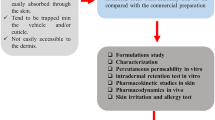Abstract
The objective of this study was to develop and evaluate a novel microemulsion (ME) formulation containing tazarotene for targeted topical therapy of acne. Microemulsions (MEs) were formulated by spontaneous microemulsification method using 12 % Isopropyl myristate, mixed emulsifiers 15 % Labrasol-Cremophor-RH 40 (1:1), 15 % Capmul MCM and 58 % water (w/w) as an external phase. All plain and tazarotene loaded MEs were clear and showed physicochemical parameters for desired topical delivery and stability. The permeation profile of tazarotene through rat skin from selected ME formulation exhibited highest skin uptake. The microscopic observations indicated that the optimized ME had no significant effect on the microscopic structure of the skin and epithelial cells appeared mostly unchanged. The surface epithelium lining and the granular cellular structure of the skin were totally intact. The developed ME may be a potential drug delivery vehicle for targeted topical delivery of tazarotene in the treatment of acne.







Similar content being viewed by others
References
Amabade KW, Jadhav SL, Gambhire MN, Kumi SD, Kadam VJ, Jadhav KR (2008) Formulation and evaluation of flurbiprofen microemulsion. Curr Drug Deliv 5:32–41
Bachhav YG, Patravale VB (2009) Microemulsion based vaginal gel of fluconazole: formulation, in vitro and in vivo evaluation. Int J Pharm 365:175–179
Bumajdad A, Eastoe J (2004) Conductivity of water-in-oil microemulsions stabilized by mixed surfactants. J Colloid Interface Sci 274:268–276
Chen H, Mou D, Du D, Chang X, Zhu D, Liu H, Xu H, Yang X (2007) Hydrogel-thickened microemulsion for topical administration of drug molecule at an extremely low concentration. Int J Pharm 341:78–84
Desai KG (2004) Enhanced skin permeation of rofecoxib using topical microemulsion gel. Drug Dev Res 63:33–40
Djekic L, Primorac M (2008) The influence of cosurfactants and oils on the formation of pharmaceutical microemulsions based on PEG-8 caprylic/capric glycerides. Int J Pharm 352:231–239
Eicke HF, Meier W, Hammerich H (1994) On electric conductivity of infinitive clusters in water-in-oil microemulsions. Langmuir 10:2223–2227
Heuschkel S, Goebel A, Neubert R (2008) Microemulsions—modern colloidal carrier for dermal and transdermal delivery. J Pharm Sci 97:603–631
Hiuberts PDT, Shah D (1997) Evidence for synergism of nonionic surfactant mixtures: enhancement of solubilization in water-in-oil microemulsions. Langmuir 13:5762–5765
Huang YB, Lin YH, Lu TM, Wang RJ, Tsai YH, Wu PC (2008) Transdermal delivery of capsaicin derivative-sodium nonivamide acetate using microemulsions as vehicles. Int J Pharm 349:206–211
Kantarci G, Ozguney IS, Karasulu HY, Arzik S, Guneri T (2007) Comparison of different water/oil microemulsions containing diclofenac sodium: preparation, characterization, release rate and skin irritation studies. AAPSPharmSciTech 8:75–81
Liu J, Hub W, Chen H, Ni Q, Xu H, Yang X (2007) Isotretinoin-loaded solid lipid nanoparticles with skin targeting for topical delivery. Int J Pharm 328:191–195
Mohammed C, Manoj V (2000) Aerosol-OT microemulsions as transdermal carriers of tatracaine hydrochloride. Drug Dev Ind Pharm 26:507–512
Moreira TSA, De Sousa VP, Pierre MBR (2010) Influence of oleic acid on the rheology and invitro release of lumiracoxib from poloxamer gels. J Pharm Pharm Sci 13:286–292
Nasr M, Abdel-Hamid S (2015) Optimizing the dermal accumulation of a tazarotene microemulsion using skin deposition modeling. Drug Dev Ind Pharm. doi:10.3109/03639045.2015.1062512
Patel MR, Patel RB, Parikh JR, Solanki AB, Patel BG (2009) Effect of formulation components on the in vitro permeation of microemulsion drug delivery system of fluconazole. AAPS PharmSciTech 10:917–923
Patel MR, Patel RB, Parikh JR, Patel BG (2010) HPTLC method for estimation of tazarotene in topical gel formulations and in vitro study. Anal Methods 2:275–281
Patel MR, Patel RB, Parikh JR, Solanki AB, Patel BG (2011) Investigating effect of Microemulsion components. In vitro permeation of ketoconazole. Pharm Dev Technol 16:250–258
Patel RB, Patel MR, Bhatt KK, Patel BG (2013a) Paliperidone loaded mucoadhesive microemulsion in treatment of schizophrenia: formulation consideration. J Pharm Innov 8:195–204
Patel RB, Patel MR, Bhatt KK, Patel BG (2013b) Risperidone loaded mucoadhesive microemulsion for intranasal delivery: formulation, development, physicochemical characterization and ex vivo evaluation. J Drug Deliv Sci Technol 23:261–267
Rhee YS, Choi JG, Park ES, Chi SC (2001) Transdermal delivery of ketoprofen using microemulsions. Int J Pharm 228:161–170
Russell JJ (2000) Topical therapy for acne. Am Fam Phys 61:1–13
Shah KA, Date AA, Joshi MD, Patravale VB (2007) Solid lipid nanoparticles (SLN) of tretinoin: potential in topical delivery. Int J Pharm 345:163–171
Warisnoicharoen W, Lansley AB, Lawrence MJ (2000) Nonionic oil-inwater microemulsions: the effect of oil type on phase behaviour. Int J Pharm 198:7–27
Yamaguchi Y, Nagasawa T, Nakamura N, Takenaga M, Mizoguchi M, Kawai S (2005) Successful treatment of photo-damaged skin of nano-scale at RA particles using a novel transdermal delivery. J Control Release 104:29–40
Zaenglein AL (2008) Topical retinoids in the treatment of acne vulgaris. Semin Cutan Med Surg 27:177–182
Acknowledgments
All authors (M. R. Patel, R. B. Patel, J. R. Parikh, B. G. Patel) declare that they have no conflict of interest. Authors are thankful to Astron Research Ltd (Ahmedabad, India) for the gift sample of TZRT pure powder, Sophisticated Instrumentation Center for Applied Research and Testing (SICART) (Vallabh Vidyanagar, India) for providing facilities for carrying out analytical work, Gattefosse (Saint-Priest, France), Colorcon (Asia) Pvt. Ltd. (Mumbai, India), Abitec Corporation (Janesville, USA), BASF (Mumbai, India), Sasol (Witten, Germany), Lubrizol Advance Material India Pvt. Ltd. (Mumbai, India), Noveon (Cleveland, USA) for providing samples of excipients. This article does not contain any studies with human and animal subjects performed by any of the authors.
Author information
Authors and Affiliations
Corresponding author
Rights and permissions
About this article
Cite this article
Patel, M.R., Patel, R.B., Parikh, J.R. et al. Formulation consideration and skin retention study of microemulsion containing tazarotene for targeted therapy of acne. Journal of Pharmaceutical Investigation 46, 55–66 (2016). https://doi.org/10.1007/s40005-015-0213-0
Received:
Accepted:
Published:
Issue Date:
DOI: https://doi.org/10.1007/s40005-015-0213-0




